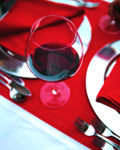 |
 |
 |
 |
 |
| For more information follow these links. |
|
 |
 |
 |
 |
|
Before putting the wine on the table, you should bear in mind some basic rules. First, adapt the wine to the dish you are going to serve, and also to those you will have the meal with.  Taste the wine and check if it is in perfect condition. Then, serve ladies first, always clockwise, starting from the first guest. You should serve the wine from the right, holding the bottle at the bottom so that the label is visible. The “host” is the last person to be served. The order in which the wines are served should also follow some basic rules. White wines are served before red wines. Light wines come before full bodied ones. Dry wines are tasted before sweet wines. Simpler wines precede the more complex ones. These are some formulas used when serving, but they can be adapted and altered. A sweet white wine can be served chilled at the beginning of the meal.
With the exception of vintage and LBV, Port wines may be drunk chilled. White Port can be drunk with ice and is usually served before the meal or with appetisers. Tawny or Ruby Ports are usually paired with desserts, but can also be served alone at the end of the meal.
 Sercial and Verdelho Madeira are usually served slightly chilled, as appetisers. After opening the bottle, the wine remains unaltered for several months.
Young Moscatel de Setúbal is usually served chilled, as an appetiser. It is quite common to add a lemon-peel to the wine. Old Moscatel, on the other hand, is usually consumed at the end of the meal.

We sometimes hear some rules that are considered “golden” when trying to match a wine with a dish. However, those rules are not to be followed blindly. They are suggestions that can help the more inexperienced. The rule that says fish should be accompanied by white wine can be replaced by a young, not very full bodied red wine.
Wine should be chosen according to ones’ personal taste, but also bearing in mind the accompanying dish. Some foods and sauces, such as sparrows, vinegar, citrines, boiled eggs, fatty smoked fish (as, for instance, salmon) and chocolate are particularly difficult to combine with wine. It is also difficult to match wine with oriental dishes (as, for instance, Japanese and Indian). You will have to use your imagination and try to find the perfect match.
Wine/food combinations can be made by resemblance or contrast. When combining by resemblance, the wines with discrete aromas are matched with lightly seasoned food; highly seasoned dishes are accompanied by very aromatic wines. Old, full bodied wines are associated with more sophisticated dishes, while the usual dishes are matched with young, fruity wines. Combination by contrast in based on the following principles: sugar softens acidity and acidity decreases fat.
|